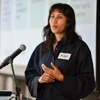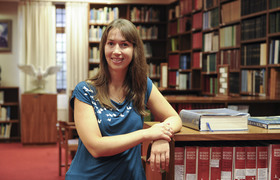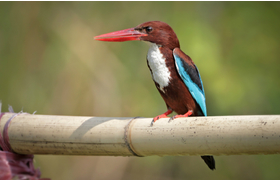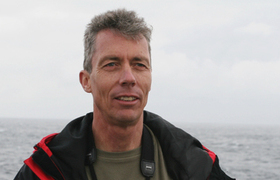Boosting the breeding success of hornbills
20 December 2017 | Story Helen Swingler.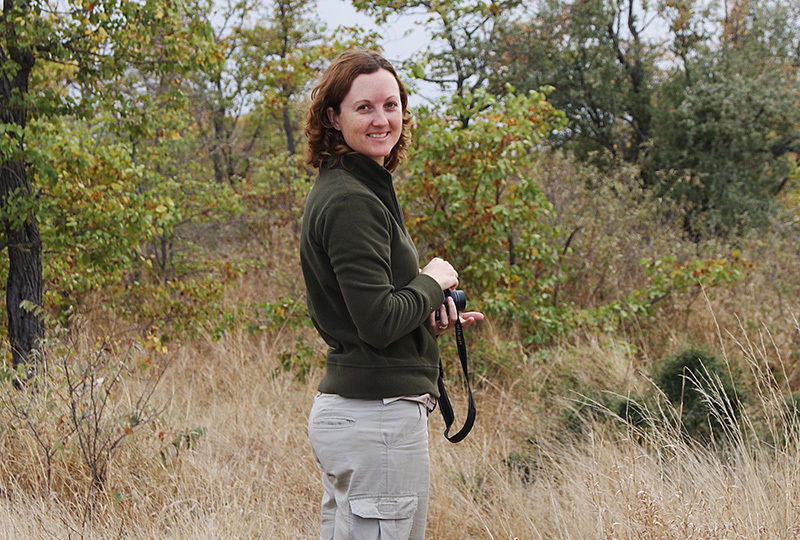
Fear of heights, floods and being mistaken for a poacher punctuated Kate Carstens’ PhD fieldwork on the Southern Ground Hornbill (Bucorvus leadbeateri) in the Limpopo Valley and Lowveld regions. Carstens assessed the role of artificial nest boxes to boost breeding success, a tool for conserving these endangered birds.
Carstens will graduate with a PhD in conservation biology on 20 December, one of 112 doctoral candidates who will be capped on the day. Her thesis was supervised by the Percy FitzPatrick Institute of African Ornithology’s Professor Peter Ryan and co-supervisors Drs Rob Little and Robert Thomson.
Flagship species
Ground hornbills, the flagship species of the African savanna biome, are cooperative breeders. Habitat loss is one of their biggest threats, with only 20% of their habitat protected. Ground hornbills are among the 13% of bird species worldwide that have been listed as globally threatened: vulnerable, endangered or critically endangered.
When needs be, birds use a broad range of fabricated structures for nesting: buildings, pylons, hollow fence posts and bridges. But nests can also be tailormade: burrowing chambers and platforms, even artificial islands. However, the nesting box is the most common for cavity nesting birds such as ground hornbills and parrots, particularly in habitats where logging, felling trees for firewood and forest clearing for agriculture are prevalent.
Carstens writes, “There are approximately 660 ground hornbill groups in South Africa, based on a maximum population estimate of 2 380 individuals and a mean group size of 3.6 individuals per group. Given that the population is declining, a critical step is slowing this decline and ensuring that all these groups can breed successfully.”
Much of Carstens’ fieldwork took place in the Associated Private Nature Reserves comprising the Klaserie, Timbavati, Umbabat, Balule and Jejane reserves adjacent to the Kruger National Park. Her aim was to assess the productivity and number of breeding groups in the region.
She also investigated the value of providing artificial nest boxes to boost reproduction and described novel insights into the dispersal of individuals in a study area supplemented with nest boxes.
Unique nest boxes
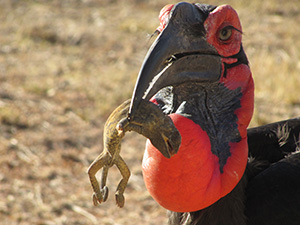
Artificial nesting boxes are a key conservation mechanism. Constructed from pine and eucalyptus logs, each weighing around 100 kg, the nesting boxes Carstens deployed are “pretty unique”.
“They’re probably some of the largest nest boxes in the world.”
These were made mostly by the staff in the Klaserie Private Nature Reserve, one of the game farms that Carstens accessed during her study. Others were made by her fieldwork partner and husband Cass.
The nest boxes brought good news. Carstens’ study found that breeding success averaged 14% higher in nest boxes than in natural tree cavities. She also found that predation levels (predation is a major factor in nest failure in as many as 42% of nests) weren’t significantly different between nest boxes (10%) and natural nests (12%).
Nature and nurture
Carstens has always been a birder. A river ran through the Pinetown family home, attracting “amazing birdlife”: Narina Trogons, Green Twinspots, Trumpeter Hornbills and Red-capped Robin-chats visited regularly.
“In between riding bikes and climbing trees, many enjoyable hours were spent with ‘bins’ [binoculars] and field guide in hand. Not much has changed.”
After an undergraduate degree and honours at the University of KwaZulu-Natal (UKZN), Carstens did her master’s jointly between UKZN and molecular ecologist Professor Terry Burke’s laboratory at Sheffield University.
The fieldwork for Carstens’ PhD began in 2011 when she joined the FitzPatrick Institute’s Ground Hornbill Project as a research assistant.
“I didn’t realise then that the data I was collecting would add to my PhD. It was only in 2014 when I registered as a PhD student that things started to take shape.”
It was fortunate also that the Fitztitute’s Ground Hornbill Project had begun in 2000, so 16 years of data were available to supplement her PhD study.
Ground hornbills are large and fearsome-looking birds, despite their showy long eyelashes. They remind Carstens of pterodactyls. But their physical appearance is secondary to their personalities, she says, “the right combination of playfulness and fierceness”.
“One of the fiercest individuals I knew was a hand-reared female called Kingfisher (from a wild nest near Kingfisherspruit, Kruger National Park). She used to fly behind bakkies and game-drive vehicles, land on the moving vehicle and intimidate anyone who happened to be sitting there.
“With some people, she was less terrifying. She used to approach me with offerings of millipedes and grasshoppers, but when I approached her to ‘receive’ these, she’d wait until the last second to change her mind, walk off and scoff the treat herself!”
Working in a Big Five area
Fieldwork in the wilds has many merits: a multi-day trail with the ecologist of Timbavati, wild camping in dry river beds. But it also demanded special reserves, as Carstens found. However, the challenges only began with living and working in a Big Five (lion, leopard, elephant, rhino and Cape buffalo) area comprised of 1 800 square kilometres of private nature reserves.
“Once you get to know how to be safe out there, read the tracks and the signs, learn how not to put yourself in risky situations with wildlife encounters, then fieldwork can be a really incredible experience.”
“Once you get to know how to be safe out there . . . fieldwork can be a really incredible experience.”
Her main challenge was overcoming a fear of heights, quickly.
“I was having to spend quite a bit of time up ladders and trees checking nest boxes for eggs and nestlings. I had a lot of people joining me for nest checks, so eventually I became the one holding the ladder while others had the fun of discovering active nests.”
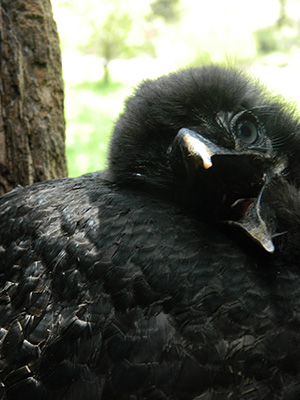
After the flood
The spring and summer rainy season made getting from nest A to nest B a challenge as the rivers often flooded. Here the project’s trusty Toyota Hilux was an asset, allowing Carstens to ford many flooded rivers.
But January 2012 was different.
“Cyclone Dando dropped 1 000 mm of rain in just two days. Our house was flooded and many of my possessions washed away to Mozambique.”
With little time to evacuate, Carstens managed to get her important pieces of equipment to safety.
She reflects ruefully, “I lost a lot of books, though, and the sorriest sight was seeing my Roberts 7th edition soaked!”
But there were lighter moments. One man retrieved a prized hornbill decoy some way downriver and carried it all the way back to the camp. They also retrieved several bottles of wine that had floated downriver.
“All of us at camp, temporarily without homes, together enjoyed a lovely evening meal complete with wine, and our feet in the river.”
Mistaken identity and a chase
Working in game reserves also meant that Carstens came face-to-face with a perennial problem: poaching.
“Poaching has changed the dynamics of fieldwork in probably all national parks with the Big Five,” she says.
She recalls heading out to a group of hornbills early one morning in the project bakkie. The game lodge she passed had been on high alert following a recent spike in poaching activity. The warden hadn’t seen the hornbill decals on the bakkie and pursued her at high speed, gun at the ready. Fortunately, it turned out well when he caught up with her.
Having husband Cass with her in the field was a boon.
The couple is now working on Cape Parrot conservation in the Eastern Cape.
“If it’s in need of conservation action, and if it’s difficult to study, I’m interested!”
 This work is licensed under a Creative Commons Attribution-NoDerivatives 4.0 International License.
This work is licensed under a Creative Commons Attribution-NoDerivatives 4.0 International License.
Please view the republishing articles page for more information.



